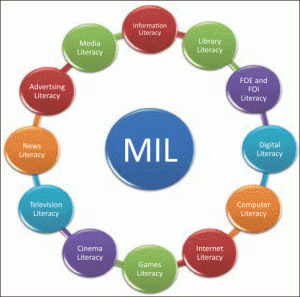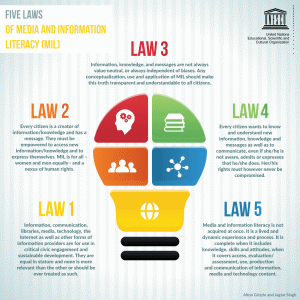
Not so long ago, certainly in my teaching lifetime, there used to be a “curriculum” commonly known as “library skills”.
The classroom teacher (occasionally a teacher librarian) would take their class to the library and teach them things like the layout of the library, the difference between fiction and non fiction, alphabetical order and Dewey classifications, the various types of reference books and how to use them, and other similar skills so that the students could be ‘independent’ users of the facility, able to do their own ‘research’ and perhaps cite the source from which they had copied their information. Workbooks and worksheets abounded and the evidence of learning was based on their successful completion.
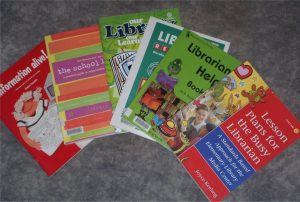
Then in the mid-90s as the phenomenon known as the Internet started to gain traction and access to it became more reliable, affordable and widespread, the walls of the traditional brick-and-mortar library began to break and patrons were able to source a wider range of information from a greater variety of sources beyond those immediately available on the library’s shelves. With this came a realisation that there needed to be a scaffold to support learners in their selection, evaluation and interpretation of all that was now accessible to them and so models of developing information literacy were created and we became familiar with such devices as
- The Big 6 and its little sister The Super 3
- The Information Process (from NSW DEC, link unavailable)
- The Research Cycle
- The Seven Pillars
- The 8Ws of Information Inquiry
- Information Fluency
- SAUCE
- The Information Search Process from Carol Kuhlthau
and a host of others including my own expanded version of the NSW model.
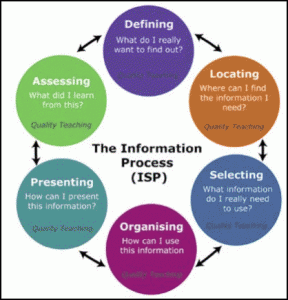
The core of the NSW Information Search Process model
Regardless of the model chosen or mandated, each one followed a similar pattern of skill development…
- A problem to be solved or a question to be answered generated a need for information.
- Locating the resources that would satisfy that information need
- Choosing the most appropriate information through analysis of its relation to the information need
- Sorting and organising the information from a variety of sources so it can be used effectively
- Using the information either personally or sharing it with others
- Considering the where-to-from-here either as a result of the new learning or as an information seeker
Whichever model was used, the development of information literacy became the specialist subject of the teacher librarian and was viewed as the focus of teaching in the library.
However, with the explosion of information as the development of Web 2.0 enabled Internet users to become creators and curators of information rather than just consumers, and the emergence of a plethora of devices which enabled anywhere, anytime access to what was online it became clear that the traditional once-a-week lesson would not be enough to ensure that students were information literate.
Information literacy is a set of abilities requiring individuals to recognize when information is needed and have the ability to locate, evaluate, and use effectively the needed information
ALA Presidential Committee on Information Literacy, 1989
Going right back to Piaget’s notion of assimilation and accommodation of new experiences being at the core of learning and with the burgeoning understanding of how humans learn based on work by those such as Marion Diamond, Bob Sylwester, Eric Jensen and Geoffrey and Renate Caine , it was clear that developing the concepts and skills necessary to undertake research and investigations was clearly something that needed to be embedded across the curriculum and taught by all teachers within the context of their discipline. The one-off, isolated lesson was not going to result in the sort of internalisation of skills and understanding that could readily be transferred to new situations. So what had been a set of discrete skills with the tag “library skills” and taught by the teacher librarian, often in isolation from anything happening in the students’ classroom, became the responsibility of all with the release of the Australian Curriculum documents and the Common Core Standards in the USA.
While this makes sound developmental, educational and pedagogical sense, many teacher librarians found it to be a very threatening situation – with no set curriculum, what would be their role in this emerging Information Age; how could they to remain relevant when “everything is on the Internet” and a growing, if fallacious perception that the more a school “went digital” the more modern and efficient it would appear to be. Having a set curriculum like other faculties appeared to be the anchor on which many relied to demonstrate their contribution to the teaching and learning of the school, their raison d’être, even holding onto their job.
Yay or Nay
In a recent informal survey of TLs across a number of international forums, all but a few of the respondents said that they would prefer a scope and sequence chart directly related to their teaching in the library. The most common reason for having such a document was that it would guide their teaching “so nothing is missed” but other reasons included
- ensuring instruction is systematic and cohesive across grades, departments and buildings
- ensuring instruction is uniform across grades, departments and buildings
- ensuring assessment is uniform across grades, departments and buildings
- ensuring that students emerged from a grade/year level with a common body of skills so standards are maintained and that there is a defined starting point for the next academic year
- providing a big-picture overview of the curriculum and what was required
- providing “ticker boxes” for skills and outcomes, particularly those in the English curriculum
- providing a framework for planning and a scaffold for teaching
- providing a guideline for skills development across and through grades and year levels particularly for new TLs as well as those more experienced
- providing a common language between the TL and the classroom-based teachers
- providing cohesion for students particularly those who move schools frequently
- providing an advocacy tool to demonstrate that there is a set curriculum and therefore there is a legitimate role for the TL within the school
- assisting the development of rubrics for assessment
- demonstrating to classroom-based teachers that TLs have skills to offer them to assist their teaching and give credibility to the TL’s suggestions
- demonstrating to classroom-based teachers, executive and principals that the role of the TL has changed
- demonstrating to parents that the TL has something to offer their students beyond the “right book”
- providing a document for successors so there is consistency across time
- providing a visual guide to what should be taught when
- helping to satisfy the need for documentation of lesson planning and data collection from assessment strategies imposed by school and district administrations
- holding students accountable for demonstrating previous learning when submitting assignments across all curriculum areas
- identifying areas of professional learning that need attention
- comparing what other schools and districts are doing
- providing documentation for personal and school accreditation
- supporting the TL’s teaching role by demonstrating it is based on a common document not a personal agenda
Those who did not view a scope and sequence chart as an essential document were primarily concerned with it
- isolating, or at best, marginalising, the TL’s knowledge and skills to discrete lessons that do not reflect or relate to what is happening in the classroom
- promoting a belief by both staff and students that information literacy is “bizniz bilong library” taught only by the ‘expert’ TL rather than something that should be an across-curriculum perspective that can be taught by all
- sidelining the TL from the teaching roles in the schools, putting them back into the role of the resource provider
- becoming a tick-a-box document that is inflexible and which has little relevance to student needs, interests and abilities
- suggesting that the development of concepts and skills and the use of scaffolds is linear rather than recursive
- becoming more important than the students’ learning so differentiation becomes minimal
- limiting the integration of information literacy into the curriculum as a whole so students do not build their own scaffolds for learning something new
- limiting the opportunities for students to grow their own understanding at their own rate because of a lock-step approach that might not allow Kindergarten students to use a digital camera, for example
- suggesting that information literacy is a skills-based continuum that can be measured and reported on rather than a spiral curriculum that leads to a greater ability to assess, interpret and use information as an adult
- becoming prescriptive, restrictive and conclusive rather than needs-based, responsive and flexible
- becoming a set-in-concrete document that is a blueprint for a significant period
- promoting a one-size-fits-all approach with all schools and all students having the same profile and needs
- promoting the perception that information literacy is a discrete set of skills that can be taught and learned in isolation
- limiting the conversations and collaboration between TL and classroom-based teachers as the latter consider the TL has a syllabus to teach and should just get on with it
- preventing the opportunities for serendipitous learning or going off on student-directed tangents because of the need to “follow the curriculum”
The scope
Before the issue of yay or nay can be decided, it is necessary to consider what such a document might contain. The fundamental element of a scope and sequence document is its scope and fundamental to that is its focus. Being a fan of Stephen Covey’s habit of “Begin with the end in mind” and Simon Sinek‘s “Start with why”, identifying the purpose of the document is essential in order to not only determine its focus but also to make sure that all that is done (and the workload is substantial) is aligned to the vision so it is on target, relevant and meaningful. So what would be the purpose of the document – a flexible guide for planning teaching or a tick-a-box assessment of learning? Being a fan of Stephen Covey’s habit of “Begin with the end in mind” and Simon Sinek‘s “Start with why”, identifying the purpose of the document is essential What would be its key focus? What should be the overarching driving force?
- Information Literacy?
- Critical Thinking?
- Creative Thinking?
- Digital technologies proficiency?
- Digital Citizenship?
- Media Literacy?
- Inquiry skills?
- Inquiry pedagogy?
- Visual Literacy?
- Cyber safety and security?
- Cultural and social understanding?
- Knowledge Building?
In a presentation to local teacher librarians in February 2017, Dr Mandy Lupton demonstrated that all of these, and many more, were elements of a wide range of models that could be associated with information literacy and be considered the realm of the TL.
Using Article 19 of the Universal Declaration of Human Rights that states
Everyone has the right to freedom of opinion and expression; this right includes freedom to hold opinions without interference and to seek, receive and impart information and ideas through any media and regardless of frontiers
UNESCO has been developing a Media and Information Literacy program to provide “access to an international, multimedia and multi-language media and information literacy (MIL) teaching resources tool for educators, researchers and individuals….[to facilitate] intercultural/interreligious dialogue and mutual understanding through MIL.”
Media and Information Literacy recognizes the primary role of information and media in our everyday lives. It lies at the core of freedom of expression and information – since it empowers citizens to understand the functions of media and other information providers, to critically evaluate their content, and to make informed decisions as users and producer of information and media content.
This covers the elements in this diagram.
One has to wonder if it would be useful, let alone feasible to produce a document that covered all these elements let alone any other add-ons such as the General Capabilities of the current Australian Curriculum.
Having decided on a definition and the parameters, there are still questions to ask and decisions to be made.
- Will the document be one that describes outcomes, skills or standards?
- Given that some aspects of information literacy are the same for Kindergarten as they are for year 12, just at a different degree of sophistication, will the document be driven by big-picture ideas for lifelong learning such as “Students will learn to use ideas, information and images ethically” or will it be more piecemeal such as “Students will learn to cite sources using title and author”?
- Will it be enough to troll the key curriculum document looking for appropriate outcomes and indicators or should other ancillary documents such as the ISTE Standards be incorporated?
- How will the “21st century skills” be incorporated and addressed?
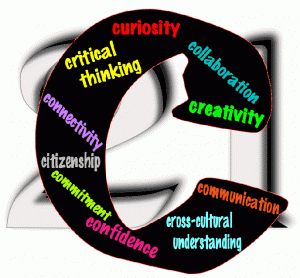
- How will differing needs and circumstances be addressed such as access to reliable, robust and affordable Internet access?
- In her analysis of the current Australian curriculum, Mandy Lupton found that even within what is supposed to be a national document, those writing each subject strand did not use the same language for the same concept so how will this be addressed so there is common language and understanding?
The sequence
Perhaps is would seem easier to identify the sequence of skills to be learned. But again, there are many aspects that need to be considered…
- In Inquiry Skills in the Australian Curriculum Lupton found that there was not consistency across the subject strands as to when a particular concept was introduced. What might come in Year 3 in one area did not appear till Year 9 in another. There seemed to have been few or no common conversations about what should come when and at what level of sophistication.
- In the case of the Australian Curriculum, it is always changing (Lupton’s matrix of 2012 is now out of date) and states have adapted it or overlaid their own requirements on top so it becomes more ‘personalised’. Thus the purpose of establishing a common body of knowledge is blemished.
- While all schools are expected to follow the Australian Curriculum, different approaches to addressing it are taken, including the International Baccalaureate so delivery and expectations are shaped by these.
- Many schools see the library and the teacher librarian as part of the English faculty yet, in the Australian Curriculum, there are few English strand outcomes that directly focus on the development of information literacy
- The role of the TL within the school is unique to that school – some provide cover for teacher preparation and planning; others co-operate with teachers to run a parallel program; some collaborate in both planning and teaching; some are directed by teachers or executive to provide specific instruction of discrete units of work; some are so micro-managed that they can only read aloud to students for fun every second week; some are autonomous in their programming; some see students daily, some once a week, some for a term or semester a year, some only when the teacher or student comes to the library with a specific purpose – so adherence to and completion of a set document would be problematic
- The development of information literacy and inquiry skills are not linear – it is a recursive practice as information seekers go back and forth according to purpose and need – yet a traditional matrix would not reflect this. While an experienced TL might be able to factor this in, it might be confusing for a new TL or a principal expecting to see boxes ticked as taught.
- Learning is a spiral that is unique to the individual learner so how would the concepts of “introduction, consolidation, mastery” (or similar terms) be addressed and depicted?
- Mastery of a concept is demonstrated when its associated skills are transferred to new, unrelated situations and the learner can explain what they have done and teach others but this might not ever be apparent if the TL is working in isolation and it may not ever occur within the students’ time in formal education. There is not necessarily an endpoint to becoming information literate.
- While the original intention may be different, many scope-and-sequence documents become a tick-a-box checklist particularly in the current climate of testing, testing, testing and data collection so what happens to those for whom learning is not easy or very easy and who have the right to have their needs met?
- In a time of differentiation, does imposing a lock-step curriculum take us back to the outdated, fallacious notion that one size fits all?
Maybe UNESCO has provided the beginning of the answer. They have attempted to bring together the fields of information literacy and media literacy into a combined set of knowledge, skills and attitudes required for living and working in the 21st century by identifying the Five Laws of Information and Media Literacy.
Returning to the big-picture view perspectives of Covey and Sinek, even McTighe and Williams’ Understanding by Design which place the end result at the beginning, these laws could be a sound foundation for any scope-and-sequence document. If we believe Law 5 which begins “Media and information literacy is not acquired at once. It is a lived and dynamic experience and process” then it may be possible to take the other four laws and ask what each might look like at each year level; what knowledge, understandings, skills, attitudes and values are appropriate for this law at this level for these students so that any document that is produced has a common direction and cohesion using the curriculum outcomes you are obliged to address while acknowledging that there is no one-size-fits-all as the tick-a-box testers would like.
Creating a scope-and-sequence document is easier to say than do. There are many arguments, both conceptual and practical, for and against its creation and its use. Conversations with colleagues and social media messages suggest that there is a desire for such a document to provide direction and clarification but I suspect that this post has created more questions than answers!
